Gallery Exhibitions
Downtown & East LA

2040 Camfield Ave.
Los Angeles, CA
1/17/2018 — 3/31/2018
Since the late 1980s, Yolanda Gonzalez has been a mainstay of the L.A. art scene, as well as a highly sought after artist throughout the United States, Europe, Japan, and Mexico. A retrospective of her work spanning the last 30 years, this exhibition displays the artist's global awareness of patterns, shapes, colors, and subject matter through paintings, sculpture, installation, and mixed media works.
Image Caption: Yolanda Gonzalez, Sueno de Alicia, 2011, acrylic on canvas. 40 x 30". Courtesy of the artist and the AltaMed Art Collection, Los Angeles.
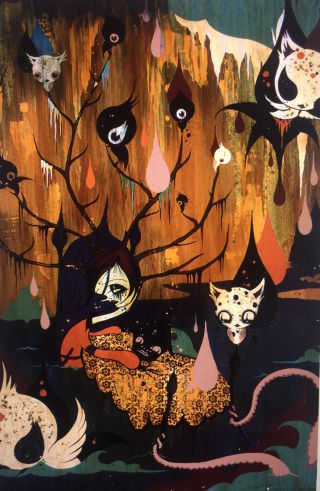
The exhibit examines artworks produced by women artists post the Chicano Art Movement and the groundbreaking collectives such as Los Four and ASCO. Inspired by the radical changes of the 1980s, 1990s, and the new millennium, this new wave of Chicana artists, including Judy Baca, Diane Gamboa, Camille Rose Garcia, Yolanda Gonzalez, Judithe Hernandez, Patssi Valdez, Linda Vallejo and more introduced remarkable artistic philosophies and methodologies into the art historical canon. Over 20 artworks will be on view, including paintings, photography, mixed-media sculpture, drawings, video, and installation.
Image Credit: Camille Rose Garcia, Green Night Deluge, 2005, acrylic and glitter on wood. 29.5 x 23". Courtesy of KP Projects, Los Angeles.
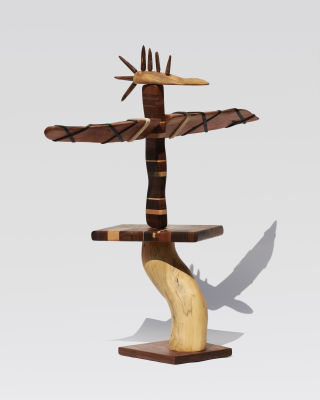
Lorenzo Hurtado Segovia's work seeks to find its place within contemporary art while still being deeply rooted in traditional practices. He attempts to redefine Christian themes and open up a conversation that is reinvigorated by points of view that depart from conservative dogma. His work is an intricate and multilayered synthesis of figuration and abstraction.
This exhibition introduces Hurtado Segovia's sculptural work with an emphasis on traditional woodworking techniques. Known for his Papel tejido (Woven Paper) works, the exhibition marks a turn toward figuration and drawing. Hurtado Segovia continues his use of pattern and textile influences while exploring new materials such as tar sourced from the La Brea Tar Pits.
Image Credit: Lorenzo Hurtado Sergovia, Kuntur Amary, 2017, 31 x 28 x 14". Courtesy of the artist and CB1 Gallery. Photo Credit: Jay Oligny.

Bringing together a group of multi-cultural artists now resident in Los Angeles, works in On Going Home examine personal and cultural heritage; and the unique, tertiary culture born from experience in these multiple worlds. The exhibition features artists Tanya Aguiñiga, Carmen Argote, Shagha Ariannia, Regina Mamou, and Alexis Zoto.
Image Credit: Regina Mamou, Untitled from the series An Island Is Just An Island (detail), 22 in. diameter, mixed media on
paper, 2017. Copyright Regina Mamou. Courtesy of the artist.

Alternate Habitats focuses on Latin American artists, bringing together works that are culled from both spiritual and site-specific inquiries. The exhibition includes works by Emilia Azcarate, Elda Cerrato, Guillermo Deisler, Mirtha Dermisache, Rafael Hastings, Leandro Katz, Marta Minujín, Norberto Puzzolo, Luis Roldán, Eduardo Santiere and Horacio Zabala. This exhibition is mounted in collaboration with Henrique Faria Fine Art in the interest of re-invigorating Los Angeles as a dynamic platform for the interchange of ideas.
Image Credit: Elda Cerrato, Pasa lo mismo en el movimiento que en el mapa?, 1976, acrylic on canvas, 14 ¾ x 22 ¼” (36.5 x 56. cm).
Image courtesy of the artist and Henrique Faria Fine Art.
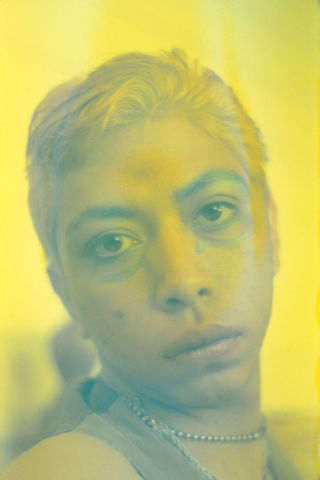
The late Gerardo Velazquez was one of East L.A.’s first Chicanos to embrace punk rock. His band, Nervous Gender, combined avant-garde approaches to noise-making with the innovations of the gestating punk rock sound and scene. Nervously Engendered documents how the band’s aesthetic pioneered by Velazquez shaped how the culture at large sees queer, ethnic, and alternative "outsiders." In addition to his radical work on stage, his recordings, and his own self as a transformative work of art, Velazquez shaped the look of his band as an art project. In the 1980s, he continued to work as an artist, assembling a provocative oeuvre that included forays into computer-based media. He tirelessly established and embodied the edge of cultural production past which few if any artists have treaded. Most West Coast experimental movements share a synergy with this relatively unknown yet radically influential figure.
Image Credit: Gerardo Velazquez. © Louis Jacinto and Coagula Curatorial. Photo Credit: Louis Jacinto.

California Locos is a vibrant collective of contemporary SoCal artists rooted in the diverse subcultures of Surf, Skate, Graffiti, Tattoo, Hot Rod, Lowrider and Music. For the last five decades, they have created their own distinct and recognized styles reflecting the kaleidoscope of West Coast experience.
California Locos: SoCal Originals--Masters of Style represents their continued contributions to the West Coast culture. Joining the Locos (Chaz Bojórquez, Dave Tourjé, John Van Hamersveld, Norton Wisdom, and Gary Wong) for this exhibition, are internationally known artists Mister Cartoon, Shepard Fairey, Estevan Oriol, RETNA, SLICK, and Robert Williams.
Image Credit: California Locos: SoCal Originals--Masters of Style. Copyright California Locos, courtesy of the artists.

A presentation of artwork by Brazilian artist, Mira Schendel. Open to the public by request and with public tours on a regular schedule (TBD) September 14-17 during opening weekend.
Image Credit: Mira Schendel, Untitled, 1950s, woodcut, 9 7/8 x 13 5/8”. © The Estate of Mira Schendel. Courtesy the Estate and Hauser & Wirth. Photo: Genevieve Hanson.
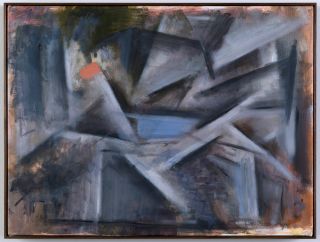
A presentation of artwork by Argentine artist, Guillermo Kuitca. Open to the public by request and with guided public tours during opening weekend on September 15, 16, and 17 at 12:00pm, 2:00pm, and 4:00pm.
Image Credit: Guillermo Kuitca, Untitled, 2008. Courtesy of the artist and Hauser & Wirth.
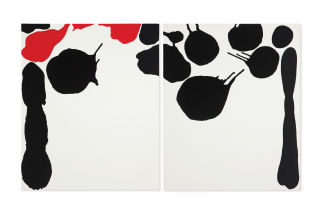
A presentation of artwork by Italian-Brazilian artist, Anna Maria Maiolino. Open to the public by request and with guided public tours during opening weekend on September 15, 16, and 17 at 12:00pm, 2:00pm, and 4:00pm.
Image Credit: Courtesy of Hauser & Wirth.

Building Material: Process and Form in Brazilian Art, features works by three generations of artists, emphasizing affinities between the materials, processes, and forms they have embraced since the Concrete and Neo-Concrete movements of the 1950s and 1960s. Building Material takes as its point of departure the work of pioneering artist, photographer, and industrial designer Geraldo de Barros (1923 – 1998), a central figure in the evolution of Brazilian art from mid-20th century onward. From his participation in the first Bienal de São Paulo in 1951, de Barros interpreted and reworked tenets of the European avant-garde to achieve a uniquely Brazilian abstraction that reflected the dynamism of a new modern society. Building Material explores the ways in which his innovations have found echoes and responses in the work of artists from subsequent generations: Rodrigo Cass, Ivens Machado, Paulo Monteiro, Nuno Ramos, Celso Renato, Lucas Simões, and Erika Verzutti.
Image Credit: Ivens Machado, Untitled, 2006. Unique work in a series of 10. Iron, mesh and charcoal. 80 x 50 x 500 cm.
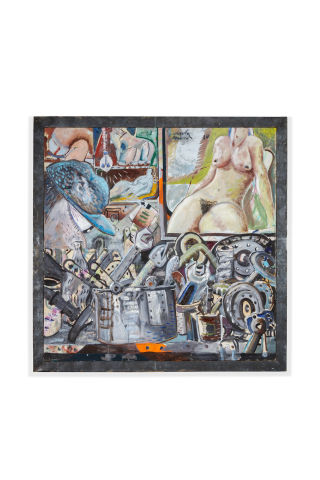
An historical exhibition, Juan José Gurrola, 1966-1989, is a survey of three projects by the Mexican multidisciplinary artist. The show gathers documents, paintings, video, and sculpture focusing on the translation of power structures in art history and Mexico´s participation or marginalization in its writing.
The exhibition features, Dom-Art (1966 - 1967), short for “Domestic Art”, was Gurrola’s interpretation of Pop Art in Latin America. The project includes a manifesto, paintings, collaborative projects, performances, and TV vignettes. Monoblock (1969-1972) consists of poems, photographs, and a bilingual performance featuring an American monobloc engine housed inside an industrial refrigerator. The show also includes works on canvas from the 1989 exhibition Trip-Tics in which Gurrola made his own versions of Philip Guston paintings. Gurrola assumed the identities of artists, from Diego Rivera to de Chirico, to make shameless, straightforward and Mexicanized bad-painting reproductions of the original artists’ work.
Image Caption: "Juan José Gurrola, Transmisión Automática (1984)
© Juan José Gurrola. Courtesy of Hours of Gaga "
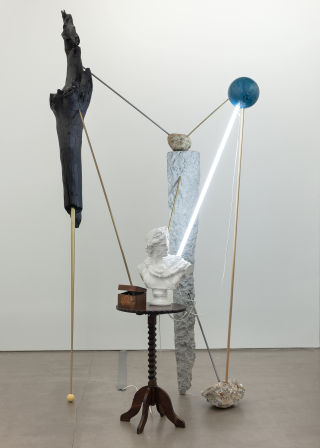
Ibid Gallery is hosting a solo exhibition of Mexican artist Alejandro Almanza Pereda, whose work explores the relationships and invisible links between sculptures, architectural spaces, and the spectator. The artist establishes a series of layered connections using visual aesthetics, precarious structures, and complex compositions of found objects. For this show, Almanza Pereda will engage viewers through dangerously fragile and seemly unstable structures. According to the artist, architectural structures are man-made shelters against the brutal forces of nature. This simple definition creates numerous dichotomies: inside vs. outside, order vs. chaos, the comfort of shelter vs. the unpredictability of wilderness. In an urban context, the outdoors is not so much “wild nature” but rather the space between thousands of “containers” in which individuals carve out a private space and fill it with personal objects.
Image Credit: Alejandro Almanza Pereda, Sticks and Stones N.4, 2015, concrete, bust, table, driftwood, brass, fluorescent light bulb, and found objects. Courtesy of the artist and Ibid Gallery.

Ibid Gallery presents a solo exhibition by Rodrigo Matheus, a Brazil-born Paris-based artist working in the realm of sculpture, installation, and assemblage. Through the novel displacement and arrangement of objects, Matheus reflects on the inherent value placed on them by their social and economic networks. His most recent exhibition, What Separates Us, at the Embassy of Brazil in London, centers around themes of circuits of exchange and value from a cultural, social, and political point of view. It examines contemporary travel and mobility, as well as international trade and the value of art in this system, which developed from colonial and postcolonial histories. For Matheus’ first exhibition in Los Angeles, he brings to the fore, in the diverse context of this city, issues of crossing boundaries, the circulation of materials, and the creation of new meanings by awakening subjectivities not originally contained in materials.
Image Credit: Rodrigo Matheus, Border, 2015, mixed media, dimensions variable. Courtesy of the artist and Ibid Gallery.

For Emiliano Gironella Parra, art is a powerful tool to modify paradigms and preconceived stories— a tool that is key to both changing the vision held abroad about Mexico and inspiring radical change and education within the country. Artempatía, or Empathy Art, is the stimulation of our natural empathy through teaching and practicing art, as well as a set of collaborative artistic actions seeking the identification and recognition of the victims of violence and their loved ones. Parra’s work specifically addresses the violence in Mexico in connection to drug trafficking within the country, and is an attempt for reconciliation between society and police. His work directs attention towards the families of the deceased and utilizes artempatía to provide a sense of belonging for the children of fallen police officers, while also seeking to enact social and cultural change in Mexican society and around the world.
Image Credit: Emiliano Gironella Parra, Camioneta gris (Gray Van), 2010, mixed media, 99 ¼ x 59 ¾ x 37 ½” (252 x 152 x 95 cm). © Emiliano Gironella Parra. Image Courtesy of the artist.
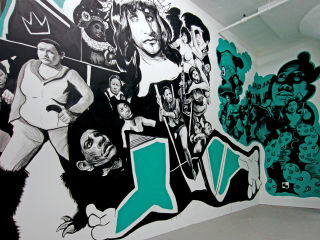
The Museum of Social Justice: 115 Paseo De La Plz.
Los Angeles, CA
9/9/2017 — 2/25/2018
Hugo Crosthwaite — In Memoriam: Los Angeles is presented at the Museum of Social Justice at the Los Angeles Plaza Historic District, in conjunction with Luis de Jesus Los Angeles. Following the ideas of impermanence and performance that are central to all of Hugo Crosthwaite's murals, the mural at the Museum of Social Justice will be created over a period of several weeks, and will be destroyed, section by section, as the exhibition draws to a close. This is the first mural that Crosthwaite has undertaken in Los Angeles and it follows other mural projects that he has created in San Diego, Oceanside, Riverside, Chicago, Tijuana, Mexico, and Cuenca, Peru. One can watch Crosthwaite at work on a mural on this short PBS documentary: https://www.youtube.com/watch?v=bauTo2C7M3Q.
Image Credit: Hugo Crosthwaite, Chicago: In Memoriam, 2016. Installation view, Mana Contemporary, Chicago, IL. Courtesy of Luis De Jesus Los Angeles.

Maccarone Los Angeles proudly presents an exhibition of architectural works by Argentina-born artist David Lamelas. The show takes place in honor of Lamelas' monographic exhibition A Life of Their Own on view at The University Art Museum at Cal State Long Beach from September 17 through December 10, 2017. Lamelas' conceptual practice has produced a diverse body of work shifting focus from Pop Art sculpture in the late 1960s to video work that parodies mass media television and examines the building blocks of narrative film. The nomadic nature of his life informs this diverse body of work, made between Buenos Aires, Paris, Berlin, Los Angeles, and many more cities in the last five decades.
Image Credit: David Lamelas, Falling Wall, 1992/2007, dimensions variable, reclaimed lumber, dry wall, studs. Courtesy of Maccarone.
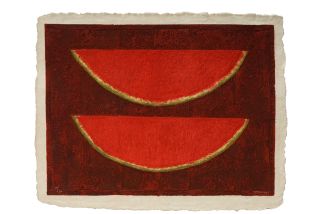
From Mexico City to LA: A Visual History of Graphic Art traces the history of printmaking in Mexico throughout the twentieth century and explores the conversation between Mexican printmaking and contemporary graphic art in Latin America and Southern California.
The show will proceed chronologically: from early prints that portray the populist and revolutionary roots of graphic arts in Mexico, to Rufino Tamayo’s role in the invention of the Mixografia printing technique, and finally to the collaborations done with contemporary Latin American artists following Mixografia’s move to Los Angeles in the 1980s. The exhibition will also examine the dialogue between the traditions of Mexican graphic art and the practices of Los Angeles-based artists, including John Baldessari and Ed Ruscha.
Image Credit: Rufino Tamayo, Sandias, 1980, Mixografia print on handmade paper, 30 x 40.” Edition of 100. © Rufino Tamayo.
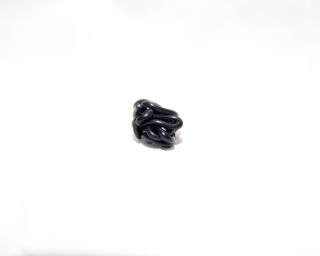
1206 Maple Ave., 5th Floor, #523
Los Angeles, CA
9/16/2017 — 10/18/2017
For Mutate, Leonardo González' Cabbages and Kings, Martón Robinson's Eat MeBite Me, and Paul Rosero Contreras' Fresh have mergd into a collaborative installation that offers the public a variety of products made with coffee, chocolate, and bananas. The selection of specialty drinks includes a type of coffee that may be impacted by the Chevron oil spill in the Amazon region in Ecuador, and a variety of cocktails once offered by the Untied Fruit Company to its investors in locations removed from the Honduran bananas plantations, in particular, London, New York, and New Orleans, as well as a variety of figures that engage with the practice of consuming dark immigrant bodies as part of the Major League Soccer spectacle.
Image Credit: Paul Rosero Contreras, Untitled. Courtesy of the artist.
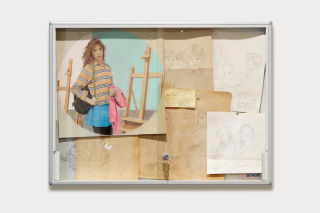
This exhibition is the first US solo show by the Argentinian artist Victoria Colmegna (b. 1986), and will comprise a series of vitrines filled with drawings done in the style of the YA series Sweet Valley High. They mix working illustrations from the series with biographical imagery from Victoria's own life as a teenager and as a woman attending art school in Frankfurt.
Image Credit: "
Victoria Colmegna, #229. Super Senior Series: Schiller Schuller in Floral Selfhood Valley, 2015; #62: Who´s Who?: Will the real Jessica please stand up?, 1990; #35.Out of Control: Will Aaron Dallas destroy Elizabeth's and Jeffreys happiness?, 1987; #66. Who´s to Blame?: Elizabeth is running away!, 1990; #41.Outcast: Will anyone speak to Molly Hecht again?, 1987; #17.Boys against Girls: Elizabeth and Jessica team up to fight there worse enemy, Boys!, 1988, 2015. Commissioned portrait and original sketches by Jimmy Mathewuse in metal vitrine, 27.6 x 39.3" (70 x 100 centimeters).
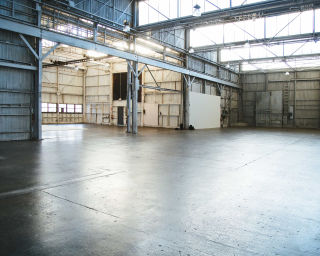
proyectosLA is a cultural platform in Los Angeles where an invited group of prestigious and innovative Latin American galleries will showcase modern and contemporary artists of that region in a curated open plan commercial exhibition.
The project is a six-week collaborative exhibition taking place in a 20,000 sq ft converted Downtown L.A. warehouse. Curated by Luisa Teixeira de Freitas & Claudia Segura, proyectosLA includes a dedicated communal gallery office space designed by award winning architect Ezequiel Farca.
Invited galleries, include: Aninat Isabel, Arredondo/Arozarena, Arróniz, Barro, Cecilia de Torres, Henrique Faria, Instituto de Vision, Leon Tovar, Nara Roesler, Nora Fisch, OMR, Páramo, Patricia Ready, Revolver, The 9.99, Vermelho, Walden and Y Gallery.
Image Credit: proyectosLA © werkartz
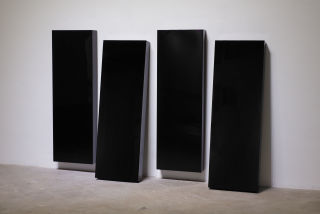
This solo exhibition highlights new works by Rubén Ortiz-Torres, including a tricked-out, hydraulic shopping cart and interactive paintings and sculptures influenced by lowrider cars, punk, anarchism, Minimalism, and the destruction and then preservation of David Alfaro Siqueiros' mural América Tropical. Born in Mexico City in 1964, Ortiz-Torres lives and works in Los Angeles and San Diego. The artist is participating exhibitions at the Petersen Automotive Museum and the University of California, Riverside's ARTSblock. He is co-curator and originator of the group exhibition How to Read El Pato Pascual: Disney's Latin America and Latin America's Disney at the MAK Center.
Image Credit: Rubén Ortiz-Torres, Black Flag, 2014, urethane and chromaluscent paint on Corafoam, dimensions variable,. Courtesy the artist and Royale Projects, Los Angeles.

El eje del mal is the inaugural exhibition at Ruberta, a new collaborative exhibition space in Glendale shared by Galería Agustina Ferreyra (San Juan, Puerto Rico), Lodos (Mexico City), Proyectos Ultravioleta (Guatemala City), Carne (Bogotá), and BWSMX (Mexico City). Each year, Ruberta will play host to a September group exhibition involving all of the participating galleries, followed by five successive two-month residencies, one for each venue.
El eje del mal features works by emerging Latin American artists Radamés "Juni" Figueroa, Adriana Lara, Adriana Martínez, Mariana Murcia, Diego Salvador Ríos, SANGREE, and Cristina Tufiño. Each of the artists involved navigates the complex terrain of Latin America’s colonial legacy and its more contemporary manifestations within a consumer society. Their tactics are diverse and often borrowed from other disciplines such as archaeology, anthropology, and theater, and are tied together by a shared interest in a pop cultural vernacular.
Image Credit: SANGREE, The Uninvited, 2016. Courtesy of Ruberta, BWSMX, and the artists. © SANGREE. Photo Credit: Elliott Cost.
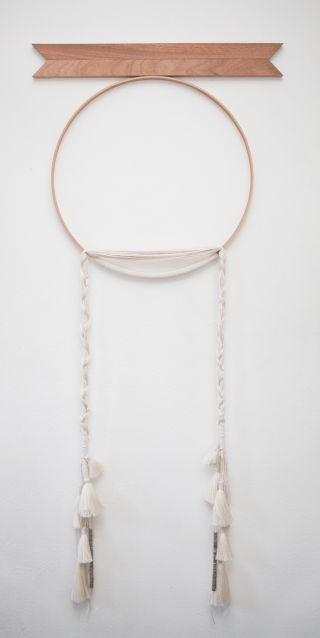
Latin America has century-old traditions of indigenous artisans working on textile manipulation: looming, weaving, embroidery, and tapestry creation. The selected group of artists manipulate fiber textiles by creating collages, sculptures, paintings, and installations that go far beyond tradition.
Simultaneously alluding to femininity and challenging art historical canons, the participating artists take it upon themselves to provoke and embrace the complexity of the medium.
The gentle yet powerful artworks allude to the socio-economic expansion in Latin America, as cotton is primarily responsible for the industry growth in Mexico, as well as the construction of a new economy in the border towns alongside the Mexico/U.S. divide and the myriad implications this presents, from capitalism to necropolitics.
Mending Structures juxtaposes tradition with political displacement. This dichotomy simultaneously evokes a return to nature and inherited heritage, while also making a critical remark on contemporary consumerism.
Image Credit: "Image Credit: Andrea Sofia Santizo., Trensa II. Courtesy of the artist.
Dysfunctional Formulas of Love brings together 27 Colombian artists, all interested in leveraging creative will for the collective good, using art as a tool to shift consciousness.
Artworks will be exhibited in the gallery's periphery, surrounding a perpetually changing central space. Over the course of the exhibition, artists will collectively build an interactive portal. Artists are constantly excavating portals through layers of reality to create spaces that don’t normally have platforms. Each gesture expands the possibility of what it can be; the portal becomes a metaphor for the possible.
Some artists will be present during the exhibition, while others will be working through proxies - L.A.-based artists who have agreed to act on their behalf.
Artists come together to understand the forces of violence, patriarchy, resource extraction, and colonization. How does one leverage personal trauma and use it for circumspection and subversion within this dysfunctional system one inhabits?
Image Credit: Eusebio Siosi, Los Sueños de la Ouutsü, 2015
Film Still, courtesy of the artist and The Box, LA.
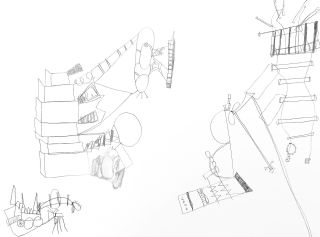
Wilding Cran Gallery presents Black Over White, an exhibition of new drawings by Maria Lynch. The drawings are composed of graphite on paper (black over white) and represent the starting point for Lynch’s colorful paintings and immersive installations that she has been developing for many years. Each work begins as a sketch with raw lines and boundless gestures that build upon one another to reveal a new composition. There is a subtle playfulness in Lynch’s drawings that suggests a new territory could be unveiled at any minute.
Image Credit: Maria Lynch, Untitled #3, 2017. Graphite on paper, 30 x 22.5 in. Courtesy of the artist.
Hollywood & West Hollywood

Juan Bastos: California Portraits, is a retrospective of 35 stunning portraits, which includes Don Bachardy, Richard Harrison, the children of Jimmy and Vicki Iovine, Ian McKellen, Patricia Morison, Charlie Munger, Rudolph Nureyev, Lawrence Platt, Dr. Alan Shabo, Valerie Sobel, Susan Sontag, Charlize Theron, Gore Vidal, Maria Vidal, Andrew and Erna Viterbi, and Hutton and Ruth Wilkinson.
Bastos is a Bolivian-American who has worked in Los Angeles for 22 years. His several-hundred, diverse portraits are displayed in California, and throughout the US, South America, and Europe. As early as 1999, the New York Times featured Bastos in a front page Arts & Culture story about the reemergence of traditional portraiture.
Private art collectors who have commissioned Bastos portraits include Philip Niarchos, Eugenio Lopez, and Pamela Joyner. Institutions that have commissioned Bastos include the University of Southern California, Good Samaritan Hospital, Cedars-Sinai Medical Center, George Washington University, and Harvard University.
Photo Credit: Juan Bastos in his Studio by Thomas Parry.
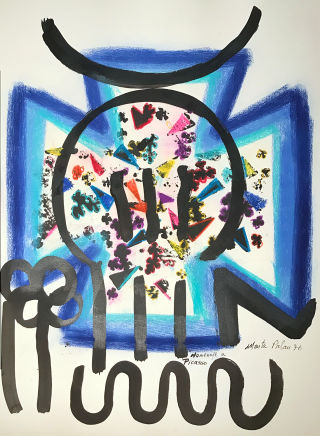
Marta Palau (Spanish-Mexican, 1934--) created a remarkable series of mixed-media collages in 1976, evidence of her struggle with ambiguities as she confronted war, machismo, and vanity, sometimes including words such as "Tal Vez" ("Maybe"), the title of her poem and our exhibition. Palau's work has been included in biennials throughout Latin America, but since the Landau Gallery show in the 70s has not been seen in Los Angeles.
Image Credit: Collage by Marta Palau. Courtesy of the artist and Denenberg Fine Arts.
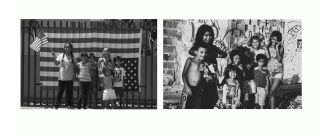
Here/There features the work of pairs of artists–one from Southern California, one from Latin America–side-by-side. Just as Los Angeles and Latin America are side-by-side and wonderfully intertwined, Here/There examines the close knit artistic relations among artists, whether related by family or artistic expression, despite the long distances between them.
This exhibition is curated by art historian Kene J. Rosa and artist Louis Jacinto, whose work has been exhibited in the Southern California area since 1980. In the last decade he has also focused on showcasing other artists via his periodic publication of onodream Magazine.
Image Credit: Here/There, 2017. Photo Credit: Ave Pildas and Waleska Santiago

f.marquespenteado’s works take the form of collages of different textiles, from natural fibers to plastic surfaces. Machine and hand embroidery serve to emancipate the designs, and enhance the iconography and fables that the work contains.
The artist aims to capture content, specifically in search of “giving narrative life to objects, to alter their course, utility, and to amplify their charm; inscribing meanings and stories to these same objects, removing their varnish so as to not be perceived as 'the [immutable] originals'; provoking collisions between images and assembling vernacular history with fantasies; fomenting a contemporary prosopopoeia, where a simple leather cushion, a tennis racket, or a lid of a tin biscuit box bare faces and voices."
Image Credit: f.marquespenteado, Unknown Subjects Among Solitaries, 2016. Installation view, Galeria Múrias Centeno, Lisbon, Portugal. © f.marquespenteado.
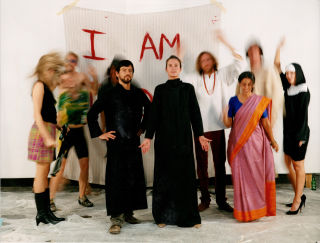
In 1994, Milena Muzquiz and Martiniano Lopez-Crozet began practicing experimental entertainment together and performing as “Los Super Elegantes” at small clubs in San Francisco. Upon moving to Los Angeles, the duo continued to record music, produce videos, and perform plays throughout Southern California, South America and Europe, inspired by their personal experiences, Latin American heritage, and a history of modern avant-garde performance and film. In 2001 they were signed to BMG Mexico, recorded three albums, and received mainstream attention as they reached the top of music charts in Mexico. Los Super Elegantes participated in the Sao Paulo Bienniel, Red Museum, Sao Paulo, BR (2007); Musee d’Art Moderne de la Ville de Paris, Paris, FR (2007); Museum of Contemporary Art, Chicago, IL (2007); Whitney Biennial, Whitney Museum of American Art, New York, NY (2004); Museum of Contemporary Art, Los Angeles, CA (2004); Hammer Museum, Los Angeles, CA (2004); and Deitch Projects, New York, NY (2003).
Image Credit: Los Super Elegantes (Martiniano Lopez-Crozet and Milena Muzquiz). © Los Super Elegantes, 2017. Photo Courtesy of Martiniano Lopez-Crozet, Milena Muzquiz, and Gavlak, Los Angeles.
Caption: Los Super Elegantes, I Am The Door. © 2017 Los Super Elegantes. Courtesy of Martiniano Lopez-Crozet, Milena Muzquiz and GAVLAK, Los Angeles.

A group exhibition bringing together nine prominent artists based in Guadalajara, Mexico, whose varied practices contribute to the city’s growing cultural ascendance and international recognition. Until recently, Guadalajara was considered one of Mexico’s most traditional cities with large industries focused on textile, artisan and craft production, perhaps best known for its ceramic fabricators and studios. Since the nineties, however, the city’s art scene has progressively flourished due to a growing number of artists who have either relocated or returned to Guadalajara to set up studios, galleries, alternative project spaces or residencies that have positioned the city as a cultural center rivaling Mexico City. This exhibition illustrates the dominant and interwoven narratives of craft, tradition and conceptual rigor that position Guadalajara as one of Latin America’s burgeoning art capitals.
Image Credit: Gonzalo Lebrija, Unfolded Gold (Metallah), 2017, gold leaf on wood, 74 3/4 x 59 inches. Courtesy of Kohn Gallery

This exhibition features works by modernists from Mexico, including Alfredo Ramos Martinez (1871-1946), Jean Charlot (1898-1979), Rufino Tamayo (1899-1991); from Argentina, such as Alejandro Xul Solar (1887-1963), Anita Payro (1897-1980); Andres Bancalari (b. 1961); and from Venezuela, Carlos Cruz Diez (b. 1923). The show relates to the Museum of Latin American Art’s exhibition, MEX/LA: ‘Mexican’ Modernism(s) in LA, 1930-1985.
Image Credit: Alfredo Ramos Martinez, Mujeres Indigenas de Oaxaca, 1944, Oil and tempera on celotex, 44 ¾ x 35 ½” (113 ¾ x 90 ¼ cm). Courtesy of the artist and Louis Stern Fine Arts.
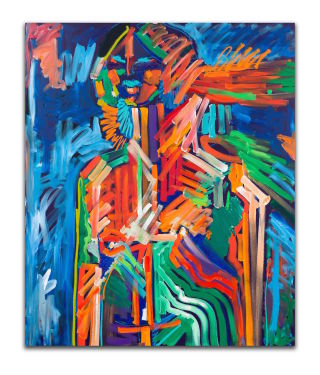
Artist Retna (Marquis Lewis) grew up in Midcity, Los Angeles. He has a mixed racial heritage, is of El Salvadorian and African American descent, and was raised among mostly Hispanic families. As an active participant within the graffiti/gang culture, Retna was inspired by his surroundings. He practiced and mastered local gang script and created his own form of calligraphy, which later developed into his fine art practice. His written artwork contains Spanish poems, symbols, and icons. This exhibition focuses on Retna’s culture via abstracted figuration in hot, vibrant colors inspired by the art of the Mexican Renaissance as well as his continued study of calligraphy. The artist has created an installation concentrating on Hispanic culture and language within the perimeter of the gallery, combining figuration and abstracted symbols with a deep bow to his heritage and city the of Los Angeles.
Image Credit: Retna, Mano y Mano. Courtesy of New Image Art Gallery .

Curated by artists Abraham Cruzvillegas and Gabriel Kuri, and titled: "Primordial Saber Tararear Proverbiales Sílabas Tonificantes Para Sublevar Tecnocracias Pero Seguir Tenazmente Produciendo Sociedades Tántricas.” —Pedro Salazar Torres (Partido Socialista Trabajador), this exhibition examines the influence of the Latin American diaspora on the global imagination, identity, and economy, with particular emphasis on Southern California. Spanning the late Modernist period to the present, the exhibition will feature pre-existing works, political documentation, and project-specific contributions. Positing a more open-ended approach to selection criteria, Cruzvillegas and Kuri cite the socio-political maps of artist and writer Miguel Covarrubias as the exhibition’s conceptual origin. This curatorial proposal includes artists living and working beyond the geographical limits of Latin America, encouraging a reevaluation of its art, borders, and identity.
The exhibition is intended to reference Martín Ramírez: His Life in Pictures, Another Interpretation at the Institute for Contemporary Art, Los Angeles.
Image Credit: Installation view of Primordial Saber Tararear Proverbiales Sílabas Tonificantes Para Sublevar Tecnocracias Pero Seguir Tenazmente Produciendo Sociedades Tántricas –
Pedro Salazar Torres (Partido Socialista Trabajador), curated by Abraham Cruzvillegas and Gabriel Kuri, on the occasion of Pacific Standard Time: LA/LA. Photo: Brian Forrest, Courtesy Regen Projects, Los Angeles
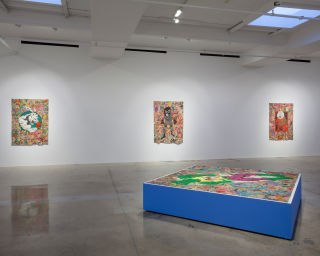
Camilo Restrepo presents a new body of large-scale drawings, the centerpiece of which measures to approximately 6 by 25 feet. Restrepo's drawings reflect on internal violence and the conflict of the Colombian drug war. His sprawling, hyper-detailed works are cartoonish phantasmagorias of various types of personal and civil aggression, representing a personal and national psyche affected by violence.
Image Credit: Camilo Restrepo, Free Function, 2016. Installation view, Steve Turner, July, 2016. © Steve Turner. Courtesy of the gallery.
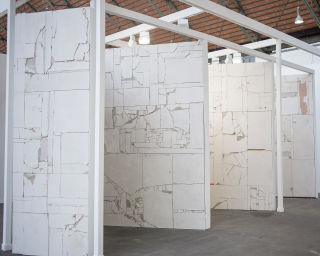
This Too Shall Pass, an installation by Pablo Rasgado, incorporates a selection of works by artists from Los Angeles and Latin America: Matthew Brandt, Joshua Callaghan, Jedediah Caesar, Emilio Chapela, Graham Collins, Gustavo Godoy, Tim Hawkinson, Kelly Kleinschrodt, Luciana Lamothe, Leo Marz, Knud Merrild, Matt Nichols, Brian Rochefort and Allen Ruppersberg. Rasgado’s architectural installation consists of wooden beams and drywall fragments recycled from used museum exhibitions that he reconfigures to create exhibition spaces for the works of the other artists.
Image Credit: Pablo Rasgado, Floorplan, Art Brussels, Installation view, Steve Turner, April 2017.
Midcity LA

1301PE presents its third exhibition with Jorge Méndez Blake, Dismantling Gorostiza. Méndez Blake who is known for his play between art, literature and architecture will exhibit a new body of work based on multiple texts by Mexican, modern writer José Gorostiza (1901–1973). Méndez Blake works with the four publications Gorostiza wrote in his lifetime: three poetry: Muerte sin Fin [Death without End], del Poema Frustrado [Frustrated Poem] and Canciones para Cantar en las Barcas [Songs to Sing on Boats] and the other an essay, Notas sobre Poesía [Notes on Poetry].
Throughout Méndez Blake’s new painting, drawing and sculpture he continues to look at the interrelation between art, literature, architecture and the notion of “dismantling of language.”
Image Credit: Jorge Méndez Blake, Untitled, 2017, acrylic on linen, 59 x 47 ¼” (150 x 120 cm). Courtesy of the artist and 1301PE, Los Angeles.

Clarrisa Tossin’s exhibition stems from her new film Maya Blue which will premier in the group exhibition Condemned to be Modern at the Los Angeles Municipal Art Gallery. In the film, Tossin responds critically to the influence of Mayan architecture on Frank Lloyd Wright’s Hollyhock House by imbuing the building with a ritualistic dance performance based on gestures and postures found in ancient Mayan pottery and murals. The score, along with the movements, progresses from delicacy to vigor, with the body eventually disappearing into the architecture. Expanding on this film, Tossin explores notions of reproduction, underlining Hollyhock House’s status as a copy, and questions where value and meaning come from.
Image Credit: Clarissa Tossin, The Mayan, 2017 (detail) © Clarissa Tossin.

Hunger As A Teacher is part of Caroline Caycedo’s project Be Dammed, 2010—, which addresses the privatization of waterways through the construction of dams, and the environmental and cultural effects of extractivism. Collaborating with the riverside populations, Caycedo gathers objects and film footage, conducts archival research, and engages in field studies in Mexico, Colombia, Brazil, Germany, and the U.S. Her drawings, collages, sculptures, films, and performances initiate a dialogue that provides tools for the creation of counternarratives regarding the impact of development-oriented projects. It is in the combination of “dam” and “damn” where Caycedo challenges the separation between the human and the natural while linking our environmental crisis to the persistence of oppression.
This exhibition connects to the artist’s book River Serpent Book and the video installation How to Fold a Dam commissioned by the Los Angeles County Museum of Art for A Universal History of Infamy.
Image Credit: Carolina Caycedo, I and I Shall Not Remove-No Nos Vamos a Dejar, 2017 (detail), archival marker on acid free paper
18 x 24". Courtesy the artist and Commonwealth and Council.
Beatriz Cortez and Rafa Esparza's collaborative exhibition at Commonwealth and Council engages with immigrant labor as a metaphor for the construction of a future where multiple imaginaries of gender, race, class, and culture are made possible. In this exhibition, the artists explore the potentialities contained in a time when tomorrow has passed—a temporality built in the future perfect tense in which a collective nomadic subjectivity can flourish.
Cortez and Esparza's work is included in the exhibition Mundos Alternos: Art and Science Fiction in the Americas at UCR ARTSBlock.
Image Credit: Beatriz Cortez, Untitled (from the series Our Roots), 2014.

Gala Porras-Kim’s work explores the social and political contexts that influence how intangibles such as sound, language, and history, have been represented through different methodologies in the fields of linguistics, history, and conservation. The work comes from a research-based practice that considers the representation of forms of communication within objects, codes, or writing, and conversely, how objects can be used to make an official narrative through artifacts. In An Index and its Histories, Porras-Kim proposes a restructuring of ceramics of Western Mexico in the Art of the Ancient Americas collection at the Los Angeles County Museum of Art. If these ceramics provide us with a formal record of their history, a series of drawings and sculptures made by Porras-Kim creates indexes of re-occurring forms that cumulatively provide a brief glimpse of life in ancient Western Mexico.
Image Credit: Gala Porras-Kim, Future Spaces Replicate Earlier Spaces (Staff/Vessel), 2016, graphite on paper, artist’s frame
30 1⁄2” x 20 1⁄4”. Copyright Gala Porras-Kim, image courtesy of the artist and Commonwealth and Council.
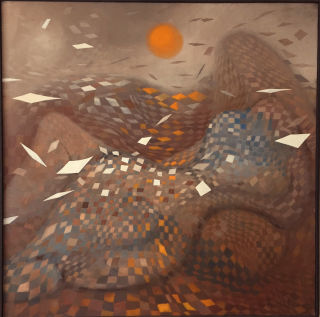
Nemesio Antúnez (1918-1993) was one of Chile's premiere painters and printmakers. His influence on contemporary Chilean art is palpable and continues to this day. In 1956, Antúnez created the influential Taller 99, a printmaking studio which revolutionized the perception of printmaking in Chile.
Antúnez’ training as an architect informed the structural basis of the imagery in many of his paintings featuring surreal landscapes and cityscapes. Domestic, national, and monothematic subjects also characterize his paintings and prints, including surreal images of bicycles, kites, stones, volcanoes, and skyscrapers, as well as multitudes of people playing the “games of life.” Images of tango dances, entwined couples, and beds emerged in the 1970s during his self-exile in Europe at the time of the Pinochet dictatorship. The works in this exhibition for will focus on Antúnez’ paintings and prints from the 1960s and ‘70s.
Image Credit: Nemesio Antúnez, Sleepers, 1964, oil on canvas, 30 x 30”. Courtesy of the artist. Photo Credit: Darrel Couturier.

Galerie Morille is pleased to present Ru-ao-objeto (Road-as-Object), the first ever solo exhibition in the United States by Brazilian artist Daniel Santiago (b. 1939, Garanhuns, Brazil). Working in Recife, Brazil, Santiago was a key participant in the international mail art movement and was also associated with Fluxus. He investigates meaning through action, collage, installation, film, and poetry. On view are two works: Ru-ao-objeto (Road-as-Object) is a work from 1974, a proposal to the viewer to experience a street in Recife, Brazil as the art work; along with this is a newly commissioned mail work, mailed as an open ended series of postcards, sent in 2017 from the artist in Recife to the gallery in Los Angeles. Post-cards continue to arrive throughout the exhibition. Ru-ao-objeto (Road-as-Object) will be performed one evening in front of the gallery.
Image Credit: Daniel Santiago, De que é que tenho medo? (What is it that I'm afraid of?), 1976. Drawing published in Commonpress 10, international magazine of Mail Art, eds. Paulo Bruscky and Leonard Frank Duch.
"
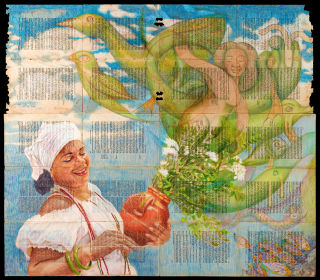
Pages from a Bahia Diary is a month-long exhibition of Los Angeles-based artist J. Michael Walker. The show highlights the artist’s portrayal and exploration of the Afro-Brazilian people and spiritual culture of Bahia based on his Sacatar Foundation Fellowship in 2011, an experience so profound that documenting and interpreting it has occupied much of the past six years. The title of the exhibition refers not only to Walker’s record of his experiences, but also to the antiquarian text on which he draws— a 17th century document of the Dutch Colonial empire of Brazil— which in turn becomes the theater in which the Afro-Brazilian women Walker befriended emerge from and dominate within the history of colonization and enslavement.
Image Credit: J Michael Walker, Her Floral-Scented Waters, 2017. Courtesy Gallery 38
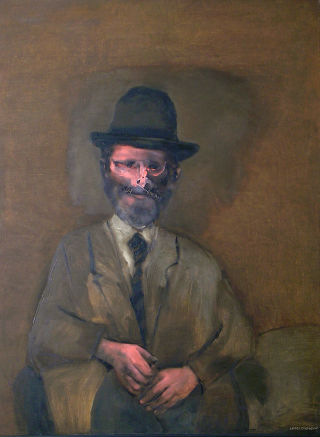
Artists of Mexico gives historical context to the Getty's region-wide endeavor, Pacific Standard Time: LA/LA, by featuring artists whose works and careers had particular resonance in Los Angeles. Their personal histories in L.A., their many exhibitions in Southern California, and in many instances through their widely known public works throughout the region reveal a profoundly important history.
Image Credit: Rafael Coronel, El Peluquero (The Hairdresser), 1965, oil on canvas. Courtesy of Jack Rutberg Fine Arts, Los Angeles.
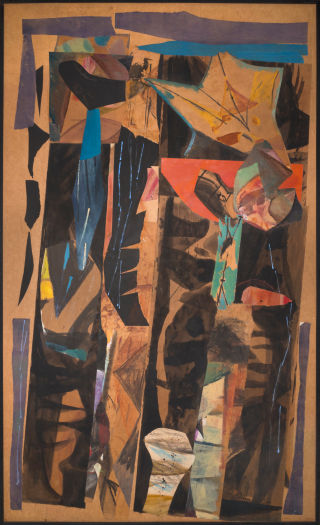
The exhibition centers on L.A. artist Rico Lebrun's (1900-1964) significant impact upon a generation of Mexican artists; particularly the Mexico's new generation of muralists, when Lebrun moved to Mexico and taught at the Instituto Allende in San Miguel de Allende.
Image Credit: Rico Lebrun, Mexican Street in the Rain, 1954, Mixed Media Collage, 110 x 65". Signed and Dated Lower Right
Reference: P52, JRFA #11246"

From 1950 to the early 1960s, Hans Burkhardt (1904- 1994) was the most widely exhibited Los Angeles-based painter associated with Mexico. His works were frequently exhibited in Mexican museums, while in Los Angeles, his paintings of the his time spent in Mexico elicited considerable critical attention. In 1959, Los Angeles Times critic Henry Seldis wrote of Burkhardt's Mexican period: "With profound understanding, deep compassion and great plastic variety [he] captures… solemn beauty and...joyous sense of release." Burkhardt's works were included in the the 1955 Bienal de São Paulo, and starting with the Metropolitan Museum of Art in N.Y. in 1950, were exhibited in museums throughout the U.S.
Image Credit: Hans Burkhardt, City At Night I, Guadalajara, 1957, oil on canvas, 50 x 60”. Courtesy of Jack Rutberg Fine Arts, Los Angeles.
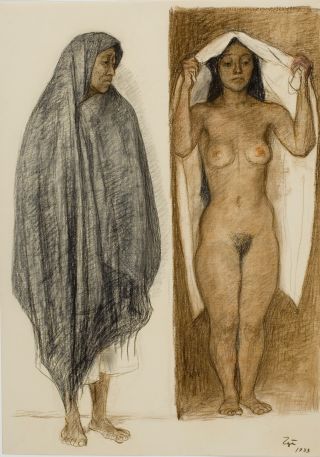
Francisco Zuniga (b. 1912 Costa Rica- d.1998 Mexico) is regarded as one of the most important 20th Century artists of Latin America. While his sculpture and drawings–primarily of indigenous women of Mexico–are widely celebrated, the political aspect of his works was initially viewed as provocative, as he dared to depict the indigenous women of Mexico as fundamentally heroic. According to the Mexican art historian Ida Rodriguez Prampolini, Zuniga was the most internationally collected artist of Mexico; nowhere is this more evident than in Southern California collections.
Image Credit: Francisco Zuniga, La Annunciacion (The Annunciation), 1983, Crayon and Pastel on Ivory Paper, 27 1⁄2 x 19 3⁄4". © Fundacion Zuniga Laborde A.C. Courtesy of Jack Rutberg Fine Arts, Los Angeles.
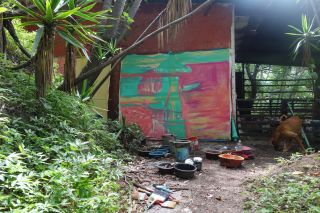
Born in Buenos Aires to exiled European parents after the end of World War II, Vivian Suter returned to Basel when she was thirteen where she studied art. On a trip through North and Central America in 1983 she found love and set down roots on the banks of Lake Atitlán. Since 2007 she has lived and worked there alongside her mother, artist Elisabeth Wild. The two women live in the dense forrest and work mostly outside. Suters paintings are exposed to the weather and inspired by the nature surrounding her. Elisabeth Wild works with paper cut outs which she arranges to colorful collages. The show at Karma International will include new works by both artists. Suters work has been brought to a broader audience in her shows at Documenta in Athens and Kassel as well as her solo show at Kunsthalle Basel and the Jewish Museum in New York.
Image Credit: Vivian Suter & Elisabeth Wild, Karma International, Los Angeles, 2017. Courtesy of the artist and Karma International, Los Angeles/Zurich.
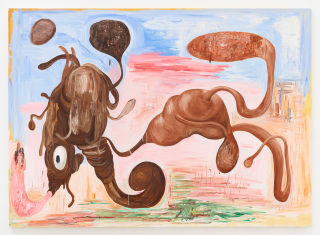
New paintings and sculpture by the LA-based Mexican-American artist, Victor Estrada.
Image Credit: Victor Estrada, Self-Transcendence / Candyland, 2015. Oil on canvas on panel, 16 x 20" (40.6 x 50.8 cm). Image courtesy of the artist and Richard Telles Fine Art. Photo credit: Marten Elder.

This exhibition features films and videos by the Argentina-born conceptual artist David Lamelas, culled from his ground-breaking and ongoing series Time as Activity, 1969–2017. These works— the first shot in Düsseldorf on 16mm film and the most recent of which streams live feeds from Athens and Berlin— investigate the durational, experiential qualities of both time and moving images. Through a series of timed image sequences, viewers witness stationary shots of streets, parks, houses of parliament, and other urban environments. Lamelas offers timestamps and durations for each scene, making viewers aware of their own location in time and space, and of the impossibility of creating unmediated representations of reality. This exhibition is presented concurrently with the artist’s first monographic exhibition in the United States, David Lamelas: A Life of Their Own, on view at the University Art Museum (UAM) at California State University Long Beach (CSULB), September 17 – December 10, 2017.
Image Credit: David Lamelas, Time as Activity London, 2011, still from a 16mm film, 16 minutes, 46 seconds. © David Lamelas. Courtesy the artist and Sprüth Magers.
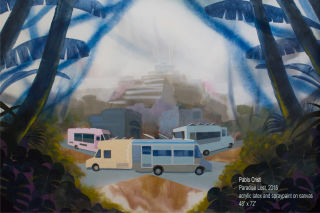
South of the Border is a fine art exhibition addressing the timely and controversial topic of immigration through the works of ten artists whose ancestral heritage connects them to several Latin American countries. Featured artists include: Lili Bernard, Marisa Caichiolo, Pablo Cristi, Joel García, Oscar Magallanes, Maja, Poli Marichal, Andrés Montoya, Sandy Rodriguez, and Votan.
In conjunction with the show, the gallery will present a panel discussion with Eileen Truax, author of Dreamers: An Immigrant Generation's Fight for Their American Dream. The book concerns the generation brought to the United States as children and now fighting to remain here legally. The panel will also include Yunuen Bonaparte and Adrián Gonzalez.
Image Credit: Pablo Cristi, Paradise Lost, 2015, acrylic, latex, and spray paint on canvas, 48 x 72”. Image courtesy of the artist.
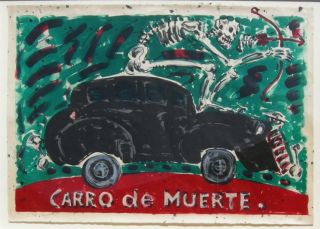
The Taller de Gráfica Popular (TGP) solidified the cultural exchange between Mexico, neighboring Latin America, and the U.S. Artists expressed societal abuses and founded The People’s Print Workshop, participating as printmakers and publishers. Through posters, woodcuts, lithographs, screenprints, and etchings, they depicted the plight of the indigenous people violated by unlawful landowners, land water appropriations, and human rights violations facilitated by “elected” officials.
Image Credit: The Taller de Gráfica Popular, Carro-de-Muerte. Courtesy of Tobey C. Moss Gallery.

For over 50 years, Romero has been part of development and renewal in Los Angeles through his topical public murals, personal screenprints, block prints, constructions and paintings. Through the enthusiasm and vigor of Romero’s art, we share a concert at the California Plaza, or a burger at Dolores’s Drive, snuggling at the Palm Drive-in or experiencing the complexity of a Freeway Interchange.
In 1974 the U.C. Irvine mounted a show of “Los Four” - Frank Romero, Gil Lujan, Carlos Almaraz and Roberto a de la Rocha that subsequently was shown at LACMA (Los Angeles County Museum of Art) and the Oakland Art Museum. Through his work today, Romero actively engages with Southern California, his Latino heritage, Car Culture, his students, his collectors, museums, the art community broadly.
Image Credit: Frank Romero, The Arrest of the Palateros. Courtesy of the artist and Tobey C. Moss Gallery.
Orange County

Descendants and Dissonance: Cultural Iconography in Contemporary L.A. brings together the work of Oscar Magallanes, Linda Vallejo, and Sonia Romero, all Los Angeles-based and deeply tied to Chicano culture and the tradition of challenging propagandist iconography through the use of irony and reappropriation. This exhibition seeks to correlate directly with How to Read El Pato Pascual: Disney’s Latin America and Latin America’s Disney at MAK Center for Art and Architecture at the Schindler House and The Luckman Fine Arts Complex at Cal State L.A., through the idea of creating identity and using iconography as political and cultural tools to represent the experiences of the people who have most suffered from corporate imperialism. Through an alchemic combination of imagery, the work aims to be a visual documentation of suppression and creation, life and death.
Image Credit: Works by Sonia Romero, Oscar Magallanes, and Linda Vallejo. Images courtesy of the artists.
San Diego
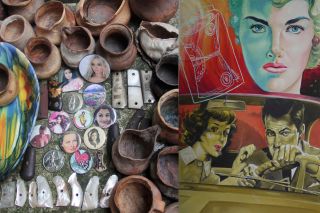
American artist Thomas Glassford grew up on the border between Mexico and California, and was submerged in this duality before finally transplanting himself to Mexico City in 1990. Glassford is fascinated by objects that have links to social commentary, and the dichotomies of feminine and masculine, function and dysfunction, are incorporated into his art practice, alongside larger themes that emerge from these starting points. Since moving to Mexico, Glassford has immersed himself in Latin American life, using found materials in his work and amassing a large collection of Mexican cultural objects that inform his art-making. This multi-faceted exhibition includes both Glassford’s sculptures and examples of his collections, including Mexican pulp fiction illustrations from the late 1950s and a unique accumulation of 19th to 20th century drinking vessels made out of bull skin.
Image Credit: Thomas Glassford, Testigo / Witness: Popular Fiction and the Dismembered Object at Quint Gallery, 2017. © Thomas Glassford. Photo courtesy of the artist.
South Bay & Long Beach
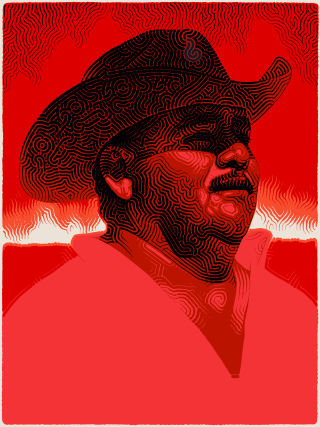
The Chicano movement in Southern California, born out of the Civil Rights movement of the 1960s, gave rise to art, murals, west coast handstyle graffiti, tattoos, and literary works along with lowrider culture and fashion as forms of self identification and cultural pride in the midst of oppression and segregation. This unique style has spread to many countries but in Los Angeles it has faced persistent attacks whether in the form of criminalization or steep fines placed on unsanctioned murals. This has created an erasure of the cultural markers that speak most clearly in opposition to systemic racism. There is a heightened urgency to preserve and document this work in the midst of rapid gentrification. This exhibition brings together artists that not only continue to use Chicano aesthetics but also uphold the use of art as a means of challenging dominant narratives.
Image Credit: Miles MacGregor, Purgatory.
West LA & Valley

A solo exhibition of works by Regina José Galindo, contemporary Guatemalan performance artist born in 1974, 14 years into the bloody, 36-year armed conflict in Guatemala. By pushing her body to the limit and creating works that depict her own reality as both a Guatemalan and a woman, Galindo challenges the inequities and atrocities that have become commonplace. When she afflicts harm on herself Galindo recalls her predecessors, artists such as Gina Pane, Chris Burden, and Marina Abramović. Her international acclaim has expanded in more recent years as her oeuvre has grown to include works that bear witness to a number of international concerns.
Image Credit: Regina Jose Galindo, Desierto/Desert, 2015, photograph, 24x36". Copyright Regina Jose Galindo. Courtesy of the Artist.
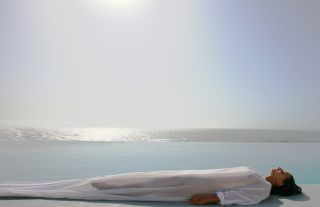
bG Gallery presents an installation by Brazilian-born artist Melissa Meier and Argentinian-born artist Marisa Caichiolo. The artists present a series using skin as a metaphor to explore issues of cultural concerns for women by interspersing sculpture, photography, clothing, and installation. While the concepts and subject matters are similar, each body of work is distinct— created out of a unique perspective and process.
Image Credit: Marisa Caichiolo, The Skin: A Land Of Discoveries #7, photograph. © 2016. Photo courtesy of Marisa Caichiolo.

For the Brown Dot Project, Linda Vallejo transforms statistics regarding the number of Latinos in various sectors into brown dots visible against a grid representing the rest of the population. Quantitative demographics (e.g. population distribution, the number of Latino police officers, etc) convert into engaging visual representations.
Vallejo creates striking, dynamic images as the discrete dots coalesce into semi-abstract ideas, pop culture icons, and sculptural forms. They form a hook, connecting the viewer to deeper issues resting within the data: Each dot becomes a poignant metonymic suggestion of a Latino reality while also forming an expressive whole.
Image Credit: Linda Vallejo, The Brown Dot Project, National Latino Firefighters 9.62%, 2016, archival marker, pigment print, watercolor paper, 11 x 8 ½”. Courtesy of the artist and bG Gallery.

Blum & Poe is pleased to present Brazilian artist Solange Pessoa’s first solo exhibition in Los Angeles. Pessoa emerged in the Brazilian art scene during the 1980s, creating sculptures, installations, performances, drawings, and videos with non-traditional materials such as hair, leather, fabric, and other organic matter. This presentation will include a variety of works and mediums. Recent group exhibitions include A Kingdom of Hours, Gasworks, London (2016), and No Man’s Land: Women Artists from the Rubell Family Collection, Rubell Family Collection, Miami, FL (2015), which traveled to the National Museum of Women in the Arts, Washington, D.C. (2016).
Image Credit: Solange Pessoa, Untitled, 2017 (detail). Soapstone
12 1/4 x 22 1/2 x 18 1/2". Solange Pessoa, Untitled, from Mimesma series, 2014-2015, soapstone 13 ¾ x 40 ¼ x 33 ½”.
© Solange Pessoa. Photo: Bruno Leão. Courtesy of Mendes Wood DM and Blum & Poe, Los Angeles/New York/Tokyo

Cherry and Martin presents an exhibition of new works by Ad Minoliti, who lives and works in Buenos Aires, Argentina. Despite exhibiting internationally, this is her first exhibition in Los Angeles. Minoliti’s paintings, videos, and sculptures, explore the relationship between eroticism, queer theory, history, and geometry.
Recent exhibitions include the Aichi Triennale 2016, Japan; Play Home at Galerie Crèvecoeur, Paris; and Case Study Cat House at Beta Local, San Juan, Puerto Rico. She was awarded the Acquisition Prize at the Arcos Dorados Latin American Painting Competition (2013), the First Prize Biennial MBA / MAC Bahia Blanca (2013), and the Acquisition Prize at the National Painting Prize Central Bank of Argentina. She was also nominated for The illy SustainArt Prize, Madrid (2015). Minoliti was recently an artist-in-residence at Frac des Pays de la Loire, France (2016) and at Gasworks, London (2017).
Image Credit: Ad Minoliti, CSH 22, 2015, acrylic on printed canvas, 55 x 39.5". Copyright Ad Minoliti, courtesy of the artist and Cherry and Martin.
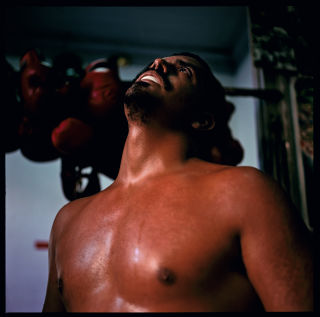
Miguel Rio Branco is renown for his use of color and the richness and complexity of his subject matter: direct, often brutal photographs of Brazilian society. His project Out of Nowhere is a documentary about the famed Santa Rosa Boxing Academy in Rio de Janeiro, named for the devotionally extravagant patron saint of Central and South America, and this show features a series of images of the boxers at the academy. In the words of David Levi Strauss, Rio Branco’s colors seep out of their borders like bodily fluids, staining and contaminating everything around them. Bodies, bindings, wounds, and walls are wet with color. The photographs reflect Rio Branco’s notorious sensuality and exuberance in their light, drama, and pathos.
Image Credit: Miguel Rio Branco, Saint Sebastian, 1994, c-print,39 ⅜ x 39 ⅜”(100 x 100 cm).Courtesy of the artist and Christopher Grimes Gallery, Santa Monica, CA.

Gianfranco Foschino is a key figure in a new generation of artists from Chile. He has developed a body of work that blurs the lines between cinema and photography. The South Gallery features a series of landscapes that the artist recorded on video by setting up a fixed camera and capturing the subtle movements that occur in front of the lens. Filmed from a distance, the scene increases in intensity as the minutes pass by with no sign of the narrative we have come to expect from video. Referring to historical precedents of early video art where the emphasis was on documentary and time, Foschino’s works engender us to pause and be present, to unplug and reconnect with our senses.
Image Credit: Gianfranco Foschino, Aymara, 2010, high definition video, silent, color, shown on a 46” LED screen with wood frame,
43 ½ x 25 ⅝x 3 ⅜” (108 x 62 x 6 ¾ cm) framed. 12 minutes, looped.Courtesy of the artist and Christopher Grimes Gallery, Santa Monica, CA

Lucia Koch uses interventions, installations, videos, and photographs to explore the means for affecting change in one’s experience of the environment. Koch has become known for photographing the empty interiors of small boxes and bags and enlarging them to architectural scale. Without making any modifications to the object, Koch photographs ordinary containers as they exist in everyday life. Once enlarged, however, the photograph functions as an extension of the physical surroundings, situating the viewers into the photograph's space and altering our perception and perspective. For this exhibition, Koch presents a series of new photographs of box interiors that have distorted, non-orthogonal shapes. The same boxes have been photographed under slightly different lighting conditions to reveal distinct movements between them. Through the viewer’s experience of these similar, repeated shapes, the time-related nature of the work is revealed.
Image Credit: Lucia Koch, Pão (Loaf of Bread), 2017, pigment print on cotton paper, laminated matte, 78 ¾ x 39 ⅜”
(200 x 100 cm). Courtesy of the artist and Christopher Grimes Gallery, Santa Monica, CA.
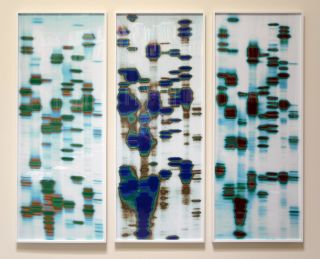
Iñigo Manglano-Ovalle creates works that are formally seductive, technologically sophisticated, and conceptually rigorous. The Garden of Delights (1998-2017) is a body of work made from the DNA samples of forty-eight participants, sixteen selected by the artist, each of whom invited two additional people to make a triptych. The DNA samples were processed and produced as digital images. Visually, The Garden of Delights alludes to abstraction, and conceptually it engages with the late seventeenth and eighteenth century casta paintings commissioned by Spanish officials in Spain’s New World colonies in the Americas that depicted the intermingling of three major races. In this work, Manglano-Ovalle examines developments in genetic sciences and their potential effects on the universal portrayal of individual identity, and offers a timely opportunity to reconsider the aesthetic and social value of such representations.
Image Credit: Iñigo Manglano-Ovalle, Suzanne, Fermin and Mel (from The Garden of Delights), 1998/2015, archival pigment prints triptych: 60-3/4 x 23-3/4 x 1-3/4" each panel, 60-3/4 x 75-1/2 x 1-3/4" overall. Edition of 3, with 2 AP

A seminal figure in the L.A. Chicano art scene, Carlos Almaraz was born in Mexico City but spent most of his life in Southern California. As a member of the collective “Los Four,” he created murals and worked with Cesar Chavez. Later he focused on mythical and shamanistic explorations, using stage-like settings, cinematic grid storytelling and floating reveries. This exhibition focuses on the relationship between Carlos and his muse/wife Elsa, two artists that shared a studio, a child, and a love story. Featuring works by both artists, the exhibition includes images of domestic bliss, nudes, dreams, and anthropomorphic animals. Presented in this show, Carlos Almaraz’ box-like houses with circles of smoke rising from the chimney, or even consumed in flames, allude to his ideals of family, and the nightmare of loss. There is a concurrent retrospective of Almaraz’s work at LACMA (Los Angeles County Museum of Art).
Image Credit: Carlos Almaraz, Domestic Scene, 1981, pastel on paper, 19 ½ x 25”. Courtesy of the Carlos Almaraz Estate and Craig Krull Gallery, Santa Monica.

One of the members of the legendary Los Angeles Chicano arts collective “Los Four,” Gilbert “Magu” Luján and his compatriots Carlos Almaraz, Frank Romero, and Robert de la Rocha, drew attention to Chicano art in the 1970s with murals and public art projects. Luján invented a plethora of mythical, fanciful creatures and cultural oddities: dogs shaped like pyramids, brilliantly colored low-rider cars inflated like balloons, strutting stick figures, and anthropomorphic rabbits in sunglasses. They populate an imaginary place called “Magulandia,” but were drawn from the essence of Chicano and Mexican culture. This exhibition explores the sources of Luján's iconography in traditional Mexican folklore and Pre-Columbian Art. Luján is also the subject of a major retrospective at the University of California, Irvine.
Image Credit: Gilbert “Magu” Lujan, Untitled, c. 2000, ink on paper, 11 x 8 ½”. Courtesy of the Estate of Gilbert “Magu” Lyon and Craig Krull Gallery, Santa Monica.
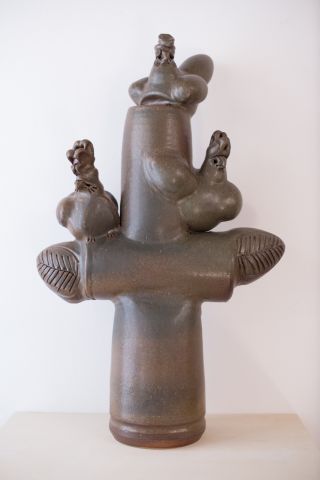
Dora de Larios is an American ceramist and sculptor who has been working with clay for over 60 years. Born in Los Angeles in 1933 to Mexican immigrants, her heritage and relationship to Pre-Columbian art is evident in her work, which embodies themes of spirituality, nature, and mythology. De Larios graduated from USC’s School of Fine Art in 1957 with a major in ceramics and a minor in sculpture. The artist studied under noted 20th century ceramists Vivika and Otto Heino, and Susan Peterson. Over time de Larios broadened her focus to include work in cast concrete, brass, stainless steel, acrylic, and wood, and produced a variety of large-scale architectural commissions. The artist was honored with a 50-year retrospective at the Craft and Folk Art Museum in Los Angeles in 2010.
Image Credit: Dora de Larios, Birds on Branches, 2013, glazed stoneware, 30 x 18”. Image Courtesy of Craig Krull Gallery.

DXIX Projects has invited artist, curator, and educator Rubén Ortiz-Torres to collaborate in the organization of a six-week program at their project space in Venice Beach, CA. This project revolves around his current art practice and continuing research interests, and consists of a set of exhibitions, performances, events, and presentations. A selection of Latin American artists and curators are Ortiz-Torres’ guests throughout the run of the show. This program complements the artist's solo outing at Royale Projects and the group exhibition How to Read El Pato Pascual: Disney’s Latin America and Latin America’s Disney, which Ortiz-Torres co-curated with Jesse Lerner at the MAK Center for Art and Architecture at the Schindler House and The Luckman Fine Arts Complex at Cal State L.A.
Image Credit: Martin Bustamante, Well Grounded, 2016. Courtesy of the artist.

One of Brazil's most renowned living artists, this exhibition marks the first time Adriana Varejão will show her work in Los Angeles. Spanning twenty years, the presentation attests to Varejão's ongoing critical dialogue with the invention of pictorial space and the conventions of modern painting, producing unprecedented artistic forms that are entirely her own: the illusory geometries of the intricately hued Sauna paintings, the visceral trompe l'oeil of the Charque (Jerked Beef) wall and floor sculptures, and the seismic Azulejão (Big Tile) monochrome paintings.
On view for the first time in U.S. is Transbarroco, Varejão's only multi-channel video installation to date. This compelling work was shot in various locations in Brazil, capturing in sweeping takes details of noted Baroque church interiors that tell a story of complex cultural exchange underscored by an ambient sound collage intercut with recitations of key writings on Brazilian identity.
Image Credit: Adriana Varejão, Rome Meat Ruin, 2016, oil on aluminum and polyurethane, 100 ¾ x 18 ⅛ x 10 ¼” (256 x 46 x 26 cm).

Christina Fernandez: Prospect features two new bodies of work, View from here and reflect/project(ion). Her new work continues several threads present in her earlier series, with a renewed formal clarity. Ideas regarding place, history, memory and legacy are strong currents within the exhibition. View from here is an ongoing series of ten photographs, depicting various windows and their views onto the exterior surroundings of a particular structure. The accompanying series reflect/project(ion) is a group of collaborative photographic portraits printed on stretched canvas.
Fernandez has calibrated the two series on view to offer suggestions about how history is presented and how one can inform or shape one's own history and the histories of others.
Image Credit: Christina Fernandez, CCJ (Leadfield), 2016, archival pigment print. Courtesy of the artist and Gallery Luisotti.
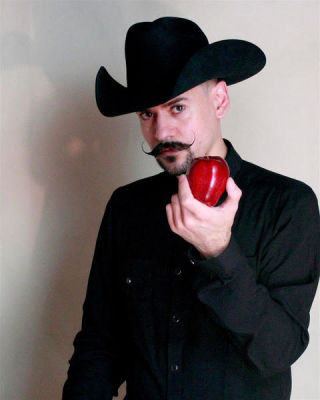
Performance 2017: Live Work is an open forum and safe space for artists whose work addresses and celebrates the complexities and challenges Mexican and South American immigrants experience while being, living, and working in Los Angeles.
Image Credit: Arturo Molinar Avitia, The Imposter, 2017, performance still. © 2017 Arturo Molinar Avitia. Courtesy the artist and Honor Fraser Gallery, Los Angeles, CA

The Unconfirmed Makeshift Museum (UMM) is a flexible artist-run space with a playful utopian sensibility, conceived as a cultural intervention in Irvine, CA by Mariángeles Soto-Díaz. For this multidimensional project, UMM was transposed to Klowden Mann, and is set up as an installation using items from a suburban living room. The exhibition contains work from UMM’s impermanent collection, including art generated through social practice events, and also features events created by diverse LA-based artists.
This exhibition relates to the Hammer Museum's Radical Women: Latin American Art, 1960-1985, REDCAT's Palabras Ajenas (The Words of Others), LA Plaza de Cultura y Artes and California Historical Society's ¡Murales Rebeldes!: Contested Chicana/o Public Art, and Laguna Art Museum's Mexico/LA: History into Art, 1820–1930.
Image Credit: Mariángeles Soto-Díaz, Scenes from UMM. Courtesy of Mariángeles Soto-Díaz and Klowden Mann.

Tell Me a Story: Contemporary Mexican Photography presents work by Mariela Sancari, Karla Leyva, Aglae Cortés, Rodrigo Ramos, José Luis Cuevas, Juan Carlos Coppel, and Fernando Gallegos, and is curated by Mexican photographer Alejandro Cartagena. This exhibition presents and examines the breadth of styles and subjects addressed in contemporary Mexican photography. From the personal to the public, and from the industrial urban city to the northern farmlands of Mexico, these seven young creators explore the possibilities of the medium and how to address the current social and political situation of a country in crisis. The show includes traditional photo-based works as well as site-specific installations.
Fernando Gallegos, Small Signs of the Ordinary, 2017. Courtesy of the Artist and Kopeikin Gallery. © Fernando Gallegos
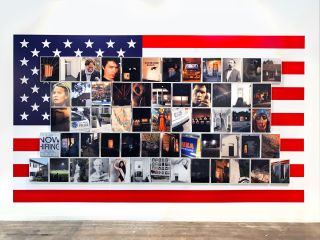
Santa Barbara Return Jobs to US or the Collective Memory of the Worst Place to Live in the World Today If You Are Not White is a presentation of new work by Alejandro Cartagena that peels away at the immediate beauty and presents new impressions of the coastal community of Santa Barbara, California. During a residency in Santa Barbara, Cartagena was interested in how the perception of Santa Barbara had been previously constructed in the mind of the outsider. Was Santa Barbara a college town and site of school shootings? Or a Hollywood haven for Oprah Winfrey and other stars? Though on the exterior this small tourist town seemed the picture-perfect American-Mediterranean escape, just under the façade seemed to lay something uneasy. Santa Barbara is Cartagena’s explorations of a narrative that that can only be felt from the outside.
Image Credit: Alejandro Cartagena, Santa Barbara Return Jobs back to US or the Collective Memory of the Worst Place to Live in the World Today If You Are Not White, 2017. Courtesy of the Artist and Kopeikin Gallery. © Alejandro Cartagena
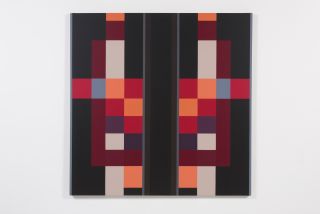
L.A. Louver presents paintings and works on paper by Fanny Sanín (b. Bogotá, Colombia). Renowned as a color field painter, this exhibition will survey Sanín's oeuvre from the 1960s to the present. Works on paper and a selection of studies accompany over a dozen paintings in oil and acrylic that demonstrate the evolution of the artist's interest and approach to color, balance, and symmetry.
Image Credit: Fanny Sanin, Acrylic No. 11, 1979, acrylic on canvas, 66 x 66”. (167 ½ x 167 ½ cm). © Fanny Sanin. Courtesy of L.A. Louver, Venice, CA. Photo: Jeff McLane.
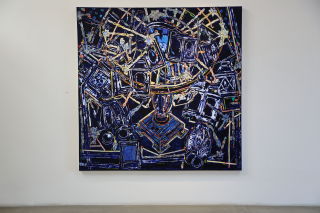
Roche’s paintings are densely layered, worked in a combination of techniques, including frottage (rubbing), grattage (scraping) and printing (monotype). Roche’s paintings are obsessed with memory; it’s burial and retrieval. Roche has exhibited worldwide, including the Art Institute of Chicago; the Museum of Modern Art, New York; the Phillips Collection, Washington D.C. and the Los Angeles County Museum of Art (LACMA).
Image Credit: Arnaldo Roche, Here the Painting is Queen, 2014, oil on canvas, 84 x 84”.
© Arnaldo Roche and Latin American Masters. Photo Courtesy of Walter Otero Contemporary Art.
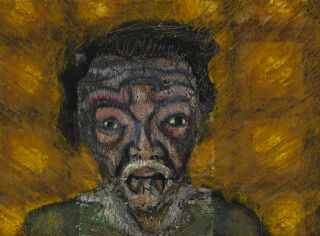
Francisco Toledo, an artist of vast formal range and varied iconography combines oil paint, watercolor, sand and collage in his work. More than a formal enlivening of his art, Toledo’s use of diverse materials reflects a worldview unbounded by categorization and hierarchy. This exhibit will feature the artist’s recent self-portraits. Toledo’s solo exhibitions include: the XLVII Venice Biennale, Venice, Italy; the Whitechapel Gallery, London; the Reina Sofía Museum, Madrid and the Museum of Modern Art, Mexico City.
Image Credit: Francisco Toledo, Untitled, 2017, mixed media on paper, 11 ½ x 5 ¼”. © Francisco Toledo and Latin American Masters, 2017. Photo Credit: Marcel Rius Baron.
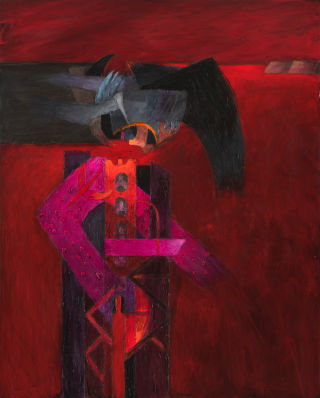
Beginning in the late 1950’s Fernando de Szyszlo created an abstract language that combined the gestural power of Abstract Expressionism with Pre-Hispanic culture. Szyszlo’s paintings distill vast areas of culture, European and American, modern and ancient, into a visual language that is his own. Szyszlo is represented in important international collections, including: Centre Georges Pompidou, Paris and the Solomon R. Guggenheim Museum, New York."
Image Credit: Fernando de Szyszlo, Regreso a Mandieta, 2016, acrylic on canvas, 59 x 47 ½”. © Fernando de Szyszlo and Latin American Masters. Photo Courtesy of Fernando de Szyszlo.
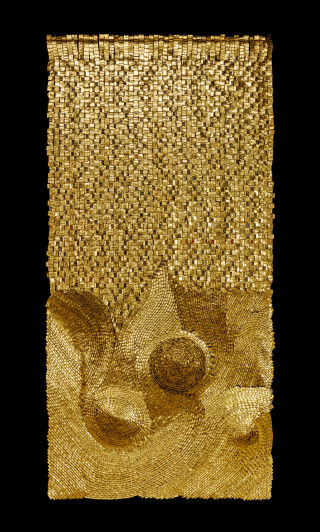
Olga de Amaral transforms two-dimensional textiles into luminous three-dimensional objects by combinung diverse materials, including fiber, gesso, acrylic and precious metals, to make works of unique aesthetic power. The exhibition will highlight her mixed-media work with gold, and runs concurrently with The Getty Center’s exhibition, Golden Kingdoms: Luxury and Legacy in the Ancient Americas. Amaral’s art is included in collections, including: the Museum of Modern Art, New York and the National Gallery, Washington, D.C.
Image Credit: Olga de Amaral, Poblado D, 2015, linen, gesso, acrylic, parchment paper, and gold leaf, 78 ¾ x 39 ½”. © Olga de Amaral and Latin American Masters. Photo Courtesy of Diego Amaral Cebellos.
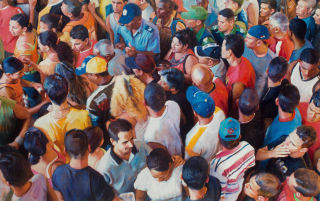
The title of this show comes from a well known poem in Cuba Yo soy un hombre sincero (I Am a Sincere Man) written in 1891 by the poet, writer, and revolutionary José Martí. Martí was exiled from Cuba for his belief in the independence of his country. His extensive travels exposed him to many cultures but never changed his love for Cuba.
Today artists in Cuba enjoy the privilege of traveling the world— showing their work, sharing their culture, and learning from their travels. Although their influences are great, the love of their culture is still present in their work.
Image Credit: Alejandro Gómez Cangas, Concretion No. 23, oil on canvas. Image Courtesy of the artist.
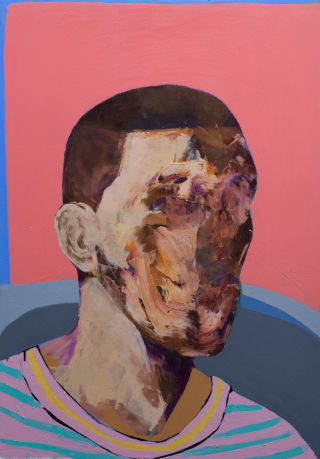
Brazilian artist Rodrigo Branco began his career in the urban art scene of São Paulo. When he was a small child, he had severe vision impairment that was left untreated for years. Later in life, he had his visual impairment corrected, but still vividly remembered the faces from his childhood— particularly the distorted, colorful faces of the circus performers that passed through his home town. During his teens he discovered the world of graffiti and began painting murals on the streets of São Paulo, portraying strange clownish and emotional faces that reflected his childhood visions.
Since he began traveling the world and becoming familiar with other cultures, his portraits have changed: The artist has created new identities and represents a more global people. His work has grown more abstract with age, and at times it now appears that all of his previous portraits overlap within a single piece.
Image Credit: Rodrigo Branco, Untitled, oil on wood, 50 x 70". Image courtesy of the artist.

Los Angeles Modern Auctions (LAMA) presents a selection of works by Emerson Woelffer. Woelffer was greatly inspired by his time living and working in the Yucatan, where he was surrounded by pre-Columbian art. A dialogue with the local art is evident in Woelffer’s work during and after this period. Although Woelffer is often known for minimal compositions, his early works draw from the regional tribal and pre-Columbian aesthetics which he discovered while living in Mexico.
Image Credit: Image courtesy of Diana Woelffer and Los Angeles Modern Auctions.

Bone-Grass Boy, begun in 1993 and debuted in 1995, was Ken Gonzales-Day’s first major body of work after completing his graduate studies at U.C. Irvine. The project sought to bring visibility to queer indigenous and Latino communities through the performative use of photography.
The project took on the 19th century literary trope of the frontier novel as a way of foregrounding border issues. In addition to geographic borders, the project sought to look at the limits of race, culture, and gender by centering the series around Ramoncita, a "two-spirit" person of mixed racial heritage played, like all of the characters in the narrative, by Gonzales-Day. These missing histories, performed before the camera, or incorporated in the fictional text of the novel, give visibility to alternative gender models that existed throughout the Americas prior to contact with the west.
Image Credit: Ken Gonzales-Day, Bone-Grass Boy: The Secret Banks of the Conejos River, 1995-2000, c-print. © Ken Gonzales-Day. Courtesy of the artist and Luis De Jesus Los Angeles.
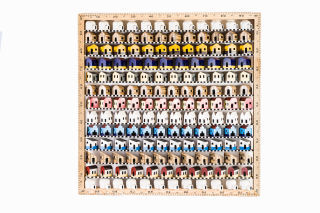
M+B is very pleased to present Pedro Friedeberg, the Mexico City-based artist’s first exhibition with the gallery. With a career spanning over six decades, the exhibition features a selection of Friedeberg’s works across a broad range of media including paintings, graphic prints, and sculptures. Friedeberg is an internationally acclaimed artist, and his work is found in more than fifty museum collections including The Museum of Modern Art, New York;, Musee d'Art Moderne de la Ville de Paris, and the Los Angeles County Museum of Art. Friedeberg's work is included in Found in Translation: Design in California and Mexico, 1915–1985 at the Los Angeles County Museum of Art and Another Promised Land: Anita Brenner's Mexico at the Skirball Cultural Center in Los Angeles.
Image Credit: Pedro Friedeberg, Infonavit de la cucarachas, 2000, painted wooden sculpture, 39 ⅜ x 39 ⅜ x 2”(100 x 100 x 5 cm). Courtesy of the artist and M+B.
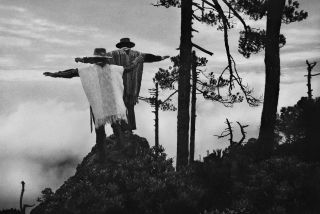
From 1977 to the early 1980s, renowned documentary photographer Sebastião Salgado (b. Brazil, 1944) traveled across Latin America from Brazil to Mexico through Chile, Bolivia, Ecuador, and Guatemala documenting culture and struggle in what was to become his major body of work, Other Americas. These images pre-date those of the Serra Pelada Gold Miners (1986) which put Salgado on the map of international photojournalists. That series was followed by his celebrated and widely exhibited Workers, Migrations, and Genesis. Still working today on photographic projects of unrivaled global scale, this intimate exhibition will showcase a rare portfolio of 20 of the most important images from Salgado’s early Latin American series.
Image Credit: Sebastião Salgado, Oaxaca Mexico, 1980. Courtesy of the artist and Peter Fetterman Gallery.

9045 Lincoln Blvd. (Galef Lobby, outside Ben Maltz Gallery at Otis College)
Los Angeles, CA
11/4/2017 — 12/14/2017
In this exhibition Beatriz Cortez engages with the life and work of Paul Popenoe, former secretary of the Human Betterment Foundation, an institution founded to further eugenic ideas in the 1930s in Pasadena, California. After World War II, Popenoe continued with his eugenics agenda under a different front, The National Marriage Project, the first marriage counseling institution of Los Angeles meant to ensure that those he believed to be the fit would remain married and reproduce.
Image Credit: Image courtesy of Beatriz Cortez.
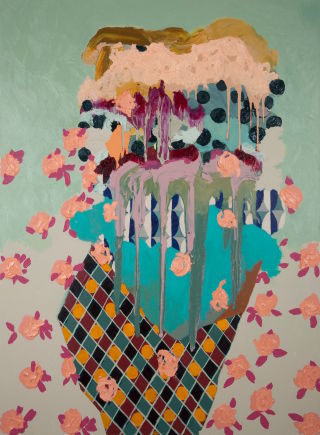
9045 Lincoln Blvd. (Galef Lobby, outside Ben Maltz Gallery at Otis College)
Los Angeles, CA
9/17/2017 — 10/27/2017
An exhibition of new work by Los Angeles-based artist Ana Rodriguez.
Image Credit: Ana Rodriguez, Untitled, 2016, acrylic and oil on canvas, 46 x 38". Image Courtesy of Ana Rodriguez.
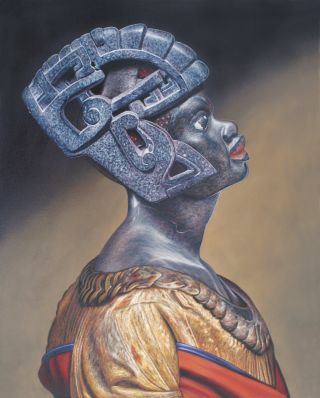
As the son of a Belizean father and nomadic Italian mother, the artist Kajahl Benes never fully identified with any one particular genealogy. He resurrects objects that are lying dormant in historical archives. The paintings are compilations of several ancient american cultures combined to create portraits of obscure origins. Although the characters he constructs belong to a multiplicity of time periods, locations and cultures, they foreground the forgotten past and reanimate minor artifacts of history into what amounts to a transformative assemblage. The exhibition relates to two Pacific Standard Time exhibitions; Golden Kingdoms: Luxury and Legacy in the Ancient Americas at the Getty Center, and also to Kukuli Velarde: Plunder Me, Baby at AMOCA.
Image Credit: Kajahl Benes, Baroque Classic II, 2017. Courtesy of the artist and Richard Heller Gallery.
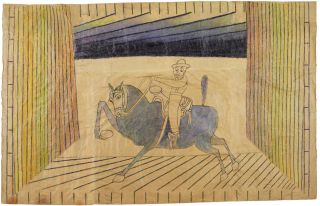
Robert Berman Gallery is showcasing select works featured in two important historical books, Hispanic Art In the United States: Thirty Contemporary Painters and Sculptors (1987), also an exhibition, and Le Demon Des Anges: 16 Artists Chicano Autour de Los Angeles (1989). Works in the exhibition date from 1960, with pieces by Martín Ramírez, and continue into the 1970s, with works by Carlos Almaraz. The show includes seminal art by other Chicano/a artists, including rare works by Harry Gamboa Jr., as well as pieces from up to the 1990s. In addition to major paintings and works on paper, the show will also exhibit ephemera and documentation of the L.A. Chicano artists from the last quarter of the 20th century.
Image Credit: Martín Ramírez, 808, Untitled (Caballero on Blue Horse), c. 1952-55, gouache, graphite, and colored crayon on pieced paper, 30 x 46”. Courtesy of RICCO/MARESCA Gallery and the Estate of Martín Ramírez
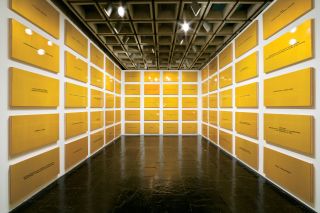
Divine Violence functions, in Daniel Joseph Martinez’ words, as “a typology of every organization in the world that uses violence or aggression to fulfill its political ideology.” The installation features panels on which political organizations are handwritten in black lettering against gold paint. Each represents diverse political and ideological modes of thinking and activity, i.e. Islamist groups, Ugandan insurgent constituencies, and right-wing Israeli factions. Martinez’ constructed sculptural database operates as a system of symbolic exchange, linking the luxury of gold to the mechanisms of power and resistance within global capitalism under the guise of wealth, power, and religion.
Divine Violence will be exhibited as a counterpoint to Martinez’ major site-specific works The House America Built and The West Bank Is Missing for LACMA's (Los Angeles County Museum of Art) Home—So Different, So Appealing: Art from the Americas since 1957.
Image Credit: Daniel Joseph Martinez, Divine Violence, 2007, automotive paint on wood panels, 24 x 36” each, overall: 153 × 275 × 187”. Installation view, Whitney Biennial 2008, Whitney Museum of American Art, New York. Collection of the Whitney Museum of American Art, New York. © Daniel Joseph Martinez. Image courtesy of the artist and Roberts & Tilton, Los Angeles, CA.
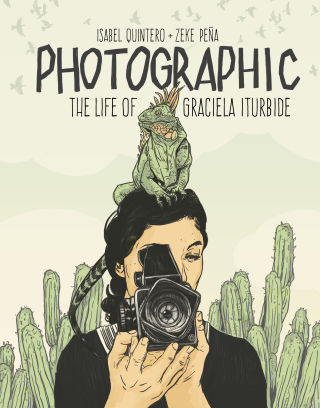
Pages from the forthcoming graphic novel about Graciela Iturbide– Photographic: The Life of Graciela Iturbide (The Getty Publications, Fall 2017)– is exhibited as a narrative along the gallery walls, interlaced with pages from the book, photographic prints by Graciela Iturbide and original illustrations by Zeke Peña.
Image Credit: The Life of Graciela Iturbide © 2018 J. Paul Getty Trust. Text © Isabel Quintero, illustrations © Zeke Pefia, photographs © Graciela Iturbide.

During the 1940s, Alex Schomburg (b. Puerto Rico, 1905) became a comic book cover artist for Timely Comics, the company that became Marvel. Spiderman creator Stan Lee has stated “Alex Schomburg was to comic books what Norman Rockwell was to the The Saturday Evening Post … When it came to illustrating covers, there was simply no one else in Alex’s league.” Schomburg brought to life such iconic characters as Captain America, the Human Torch, and the Sub-Mariner. In one short decade, the artist created over 500 comic book covers and became a legend of the Golden Age of Comics. Schomburg left the comic industry in the early 1950s to create science fiction covers for the books of notable writers. Later, he was hired to work on Stanley Kubrick’s 2001: A Space Odyssey. This exhibition will explore the artistic contributions of Schomburg to the movie, comic, and science fiction worlds.
Image Credit: Alex Schomburg, Endpaper for Winston Science Fiction, 1952 © The Estate of Alex Schomburg. Photo Credit: Dan Kvitka.
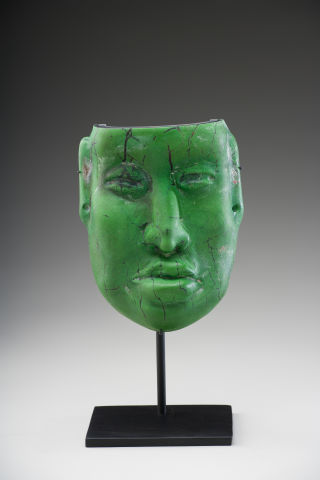
A celebration of the glass medium and of Jaime Guerrero’s own sculptural process in the context of resurrecting the work of ancient craftsmen. He approaches this endeavor from an archeological perspective, reinventing Mesoamerican sculptural figurines as a way to pay homage to the craft and the culture of that time. Guerrero explores a mythical world in which he becomes hyper-observant to an aesthetic, stylistic, and iconographic worldview. Through the process of reproducing idols in an entirely new medium, Guerrero adds a fresh and modern perspective to Mesoamerican craft. This work interprets the myths, craftsmanship, and unique forms of the ancient past to offer a modern perspective. As Guerrero states: “My artwork is a journey of diverse phases as a form of self-questioning.”
This exhibition relates to Golden Kingdoms, Luxury and Legacy in the Ancient Americas at The Getty Center.
Image Credit: Jaime Guerrero, Green Idolo, 2013, glass, 17 x 9”. © Jaime Guerrero.
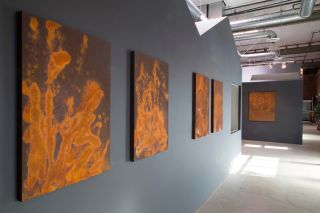
The Lapis Press presents an exhibition of Ruben Ochoa's recent work, Rust + You. The show includes rust paintings made via controlled oxidation alongside works on paper, his Lapis edition coupled with his rebar drawings, and several floor sculptures.
Image Credit: Ruben Ochoa: RUST + YOU at The Lapis Press, Culver City. Photo by Angela Hanka
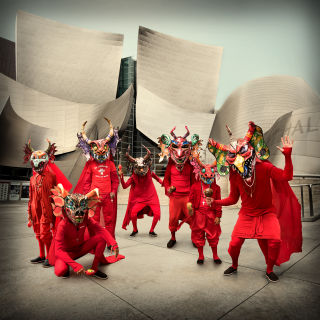
Dancing Devils of Yare is an annual festival in Cristobal Valecillos's home country of Venezuela, rooted in an 18th Century tradition of Renewal and Triumph and Good over Evil. Townspeople called prometeros (promise keepers) dress in elaborate costumes crafted from recycled materials that resemble winged dragon-devils, and dance in a parade with percussion instruments.
This celebration of creative, costumed, spirited performers has informed the artist’s multimedia art practice, including the use of nontraditional recycled materials.
For YARE: ONE MORE DANCE the artist has recreated the Dancing Devils as an art experience incorporating contemporary challenges and joys of the human spirit in Los Angeles.
The exhibition is comprised of photographs of staged parades that took place at iconic L.A. locations, utilizing the costumes. The exhibition will open on Saturday, October 21st in Downtown LA at 544 Mateo Street and continues at Timothy Yarger Fine Art Oct 23 - Nov 30th.
Image Credit: Cristobal Valecillos, Dancing Devils of Yare
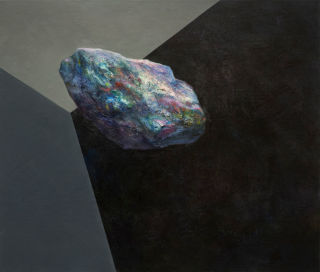
Based in Mexico City, Javier Pelaez creates work that considers the myriad possibilities involved with the construction and perception of reality. The title of this exhibition references the 1962 poem, Conversation with a Stone, written by Wislawa Szymborska. Through an imaginary dialogue between a human speaker and a stone, Szymborska examines the human desire to understand everything about the world around us and the inevitable reality that it is an impossible quest. Essentially, the stone in this poem serves as a metaphor for all that is incomprehensible to us. Pelaez invokes the primordial form of the stone, highly rendered in multi colors, juxtaposed against hard-edge, planar backgrounds. These cryptic forms seem to defy gravity, weightless yet imposing, their origins and trajectory unknown. The viewer is left with more questions than answers, as Pelaez’s paintings seem to challenge their own existence.
Image Credit: Javier Pelaez, PRGB4, 2017, oil on canvas, 35 x 42”. Courtesy of the artist and William Turner Gallery.
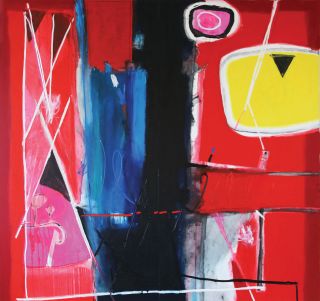
Over the past four decades, Gustavo Ramos Rivera has developed a unique visual language that manifests throughout his paintings, monotypes and collages. His playful and powerful abstract compositions can be read like a visual diary, the expression of which works on both intellectual and emotional levels. Ramos Rivera’s fields of rich color and glyph-like mark making recall both the work of Joan Miro, Paul Klee and Cy Twombly and the iconography of the indigenous cultural heritage of his native Mexico. The marriage of spontaneous linework with technicolor fields create a highly personal symbology that speaks to memory, experience and shared history. Ramos Rivera says of his practice, “Painting is a delightful devotion, a mirror of truth; it’s an invention of anything you want.”
Image Credit: Gustavo Ramos Rivera, Al Mal Tiempo Buena Cara (A Good Face for Bad Times), 2015, oul on canvas, 84 x84”. Courtesy of the artist and William Turner Gallery.
